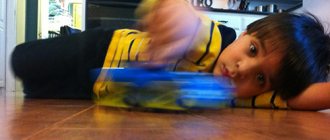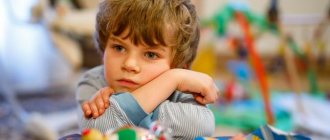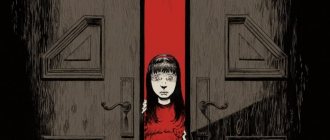There is probably not a person in modern society who has not heard of such a mental illness as autism. Its signs are also quite well known: impaired ability to communicate, empathy and the inability to establish an emotional connection even with loved ones.
A family with an autistic child has to wage a constant daily struggle with this severe pathology, because it is the patience and perseverance of loved ones that become the key to the patient’s future adaptation to life in society.
How not to miss the early manifestations of the disease in children and adults and how to help someone suffering from autism? This will be discussed in this article.
Signs of the disease in adults
All types of diseases are not only genetic disorders, but can also be acquired.
The danger of an acquired disease lies in the absence of pronounced symptoms of autism. The slow progression leads to the patient becoming withdrawn overnight and trying to isolate himself from others.
At the initial stages of the development of the disease, a person stops enjoying life, falls into deep depression, and communication during a meeting is reduced to minimal fragments of phrases. At work or in family relationships, conflicts arise that force the patient to hide from others, plunging into the abyss of his experiences and suffering. If at this moment a person turns to a psychiatrist, early diagnosis of autism and drug treatment with antidepressants can reduce the risk of developing the disease significantly.
How do signs of autism appear in adults?
- fragmentation and incoherence of speech, poverty of vocabulary. The patient constantly repeats part of the phrase without delving into the essence of what was said;
- the spoken speech is monotonous and monotonous, the person does not show any emotions;
- fear of change, attachment to objects and habits;
- indifference to what is happening, neither grief nor joy cause emotional outbursts among loved ones;
- the patient cannot be the first to make contact with others, any contact with him causes fear and stress;
- lack of tact: manner of speaking loudly or violating intimate space;
- random, thoughtless movements: scratching, fiddling with an object when talking;
- manifestation of episyndrome;
- the inability to understand the interlocutor, which makes it difficult for an autistic person to communicate with others;
- does not recognize human hugs or kisses. This fact is regarded by the patient as a restriction of freedom and frightens him.
Depending on the disturbance of the emotional and volitional sphere, 4 types of diseases (autism syndromes) are distinguished.
Features of communication
Typically, people with this diagnosis have impaired communication functions. Autistic adults often simply do not perceive information and cannot understand what is being told to them. Children do not see the point in group games.
Such people do not like to conduct dialogues. Emotional phrases and expressions of the interlocutor are often incomprehensible to them. Autistic people tend to have a melancholic temperament and speak in a monotone without showing any emotion. Often these people simply monotonously repeat phrases and statements of other people. So, when you say to a sick child: “What a beautiful dog!”, he will involuntarily repeat the word “dog.” Moreover, autistic people do not understand why they do this.
Causes of autism in adults
The only reason that affects the development of autism in adults, according to experts, is pathologies of the patient’s intrauterine development. And all other factors are just prerequisites for the formation of a clinical picture at the most appropriate moment.
The trigger mechanism in this case may be:
- changes in the established life of an adult (change of job, moving to a new place of residence, car accident, etc.);
- stress;
- emotional stress that appears as a result of a discrepancy between the capabilities of a given person and the requirements placed on him;
- a large amount of information that requires processing;
- a period of constant failures and life problems.
But long before autism, the signs of which were described in detail above, first appears, character traits such as a desire for solitude and a certain degree of isolation can be observed in an adult. Any changes frighten such people and make them feel confused.
What features of a child’s behavior should alert parents?
Parents who are attentive to their baby begin to understand quite early that their baby’s behavior is different from how his peers behave.
- The child avoids eye contact: he either looks, for example, at the lips of the speaker, or does not look at the person who is speaking to him at all.
- Unusual reaction to touch. The fact is that in a child the desire for tactile contact is genetically embedded, but autistic children avoid touch, it can cause aggression in them.
- Childhood autism, the signs of which we are now considering, also manifests itself in the child’s emphasized indifference towards his mother or, conversely, in the inability not to see her for at least some time.
- But the well-known sign of autism - love of loneliness - is not an entirely accurate definition. Autistic children simply cannot and do not know how to communicate, so they are more comfortable being alone with themselves.
- In addition to the above, such children, as a rule, do not show interest in surrounding objects and people.
Autism in adults: features
The main features of the manifestation of autism in adults depend on its main tendencies: how aggressive the disease is, how it behaves throughout life, and so on.
Characteristic features of autism in adults include:
- Weak facial expressions and gestures.
- Rejection of generally accepted rules of communication: an autistic person may behave somewhat strangely when communicating with other people. For example, speaking too loudly or quietly, not looking into the eyes - or looking into them too intrusively.
- Unawareness of behavior: it is difficult for an autistic person to understand that his actions can somehow negatively affect other people.
- Lack of empathy: Patients do not sympathize or empathize with other people. It is difficult for them to distinguish between other people's emotions and moods.
- Difficulties with personal life: Due to the above problems, autistic people find it difficult to form any kind of relationship, be it friendly or intimate. The main reason for this is the patient’s lack of autonomy and independence. In addition, often adults with mild forms of autism are too attached to their parents and do not want to move away from them.
- Weak intonation: often the speech of autistic people lacks emotional overtones and resembles the indifferent, monotonous speech of a robot.
- Pattern dependence: Minimal changes in the environment surrounding the autistic person cause negativity, anxiety and worry. There is also attachment to certain places or inanimate objects.
How and how to help a patient with autism
Treatment is selected by a psychologist after receiving the results of medical diagnostics. The main goal of therapy is to help a person adapt to the social environment, restore quality of life and prevent aggression towards other people.
Drug therapy
A mild form of autism can be corrected with the help of a psychologist. In severe cases, drug therapy will be required.
| Group of drugs | Name | Efficiency |
| Antidepressants | "Fluoxetine", "Sertraline" | Medicines normalize mood, eliminate anxiety and irritability. |
| Stimulants | "Guanfacine", "Atomoxetine" | The drugs improve the patient’s mood and increase the ability to concentrate. |
| Antipsychotic drugs | "Haloperidol", "Sonopax" | The drugs help reduce aggression and outbursts of anger. |
Medicines suppress irritability and reduce aggressive mood. The dosage of drugs depends on the severity of the pathological processes.
A psychiatrist prescribes the medications, he also monitors their intake and adjusts the treatment if necessary. You should not give medications to patients on your own, as they cause severe side effects (insomnia, drowsiness, weight loss).
To help a patient with autism, relatives need to learn how to approach the person, show more care, and behave correctly.
There are certain tips from a psychologist that will help you establish a connection with the patient:
- It is important to maintain constant contact. Otherwise, the patient will withdraw into himself.
- Help the patient cope with fear and aggression, suppress these feelings.
- Role-playing games, where you can use a large number of toys, will help to establish contact.
- It is necessary to teach a person independence, gradually instill in him the skills of self-care.
- Maintain the functioning of the speech apparatus through long conversations, discussions, and conversations on a general topic.
- Teach the patient to show emotions, rejoice or show sympathy.
- To avoid provoking stress, avoid changing the environment.
- Talk calmly, avoid aggression and swearing in communication, and avoid conflict.
- You should address the patient clearly and distinctly, but do not raise your voice so as not to frighten him.
- It is important for a person to create the most favorable conditions for existence in order to ensure comfort and prevent stress.
- It is planned to visit a speech therapist, psychologist, psychiatrist, neurologist for preventive or therapeutic purposes.
Experts recommend treating people with autism equally. These are people who have a full-fledged personality, it has its own worldview and inner world. It is important to avoid conflicts, be patient and understanding.
Other therapies
Autism in adults (signs of the disease will help you choose the most effective treatment) also involves the use of other treatment methods:
| Name | Description |
| Behavior correction | Applied Behavior Analysis - applied behavior analysis. The technique helps develop certain skills and knowledge in an autistic person so that the patient can easily adapt to society. |
| Speech therapy with the participation of a speech therapist | The treatment improves the patient’s speech, psyche and develops communication skills with other people through emotional contacts. |
| Occupational therapy | Helps improve motor skills and coordination. Occupational therapy also teaches how to use information received from the outside world through the senses (vision, hearing, smell, touch). |
| Play therapy | Speech skills improve, the patient learns to communicate with people and adapt to society. Specially designed games allow you to identify the problems of an autistic person and help him overcome them. |
| Visual therapy | Video images help to establish a connection with an autistic person using assistive communications (favorite pictures). |
Treatment in each case is selected individually. It all depends on the person’s condition and the degree of development of autism. It is important to exercise regularly and use the services of professional specialists.
Cause of autism
The cause of this pathology is still being determined. Researchers believe the disease may be caused by a combination of genetic factors and environmental influences that affect a person's brain development.
In most cases, according to scientists, the prerequisites for the development of autism are laid in the prenatal period: at this time, the child’s brain, for some reason, does not receive enough nutrients. But exactly how this failure turns into a mental illness is still unclear.
By the way, clinical experiments have not confirmed the role of heredity in the development of pathology, as well as the connection between vaccination and the occurrence of autism.
It is clearly known that autism, the signs of which we will consider in this article, is not a consequence of poor upbringing of the child or the behavior of his parents. Does not affect the occurrence and development of the disease and the patient’s social affiliation. This disease cannot be blamed on the carrier himself - he is in no way able to influence the appearance of this pathology.
How does a person with autism perceive the world?
The human brain constantly processes incoming information using visual, auditory and tactile analyzers. In an autistic person, the perception of incoming signals is impaired, and this leads to chaos: some signals become very intense, while others are not noticed at all.
This state of affairs causes a disruption in human contact with the environment. He turns into some kind of “alien” who does not know and does not follow the rules of the game. And the world and people around him turn into a source of discomfort and, accordingly, anxiety.
It is very important for parents to notice in time that their child is not like everyone else. Early signs of autism in children will help to detect these: you should know them in order to prevent the problem from worsening. After all, pathology noticed in time is easier to correct, which means it will cause fewer problems in the future.
Characteristic manifestations
Fear of communicating with people, social isolation may indicate the presence of autism
There are certain signs that may indicate that a man or woman has autism. Among them are:
- difficulties in mastering new skills;
- lack of hobbies;
- a mild form may be accompanied by involuntary, erratic movements - the patient constantly fiddles with an object, for example, a button, or scratches himself while speaking;
- lack of friendly relationships;
- the presence of deviations in speech, which can be manifested by a lisp, incorrect pronunciation of certain sounds, lack of intonation, lethargy, a poor vocabulary, unrelated conversation;
- the occurrence of panic attacks in bright light or sharp sound;
- monotonous conversations;
- lack of emotionality, reaction to various events in the family;
- the presence of a cyclical nature in activities that resemble a certain ritual;
- lack of tact;
- autism may be accompanied by muteness or hearing loss, which can lead to increased isolation;
- resistance to other people's touches, reluctance to share one's belongings;
- the appearance of aggression or, conversely, fear of interacting with people;
- lack of social skills, empathy;
- attachment to the daily routine - in the presence of changes, a feeling of threat or danger arises;
- workload of perception;
- possible lack of sensitivity to pain;
- problems with rest and sleep;
- fear of changes in life;
- attachment to certain objects and places;
- meager manifestation of gestures and facial expressions.
If you are interested in the question of how this disease manifests itself in men and women, then in the former there is a constancy that resembles cyclical activity, which can be confused with paranoia
The most important thing for such a person is to systematize the objects that surround him. With such actions, a man prevents the occurrence of panic attacks and attacks of aggression
This condition is diagnosed more often in males than in females. In the latter, autism may remain undiagnosed until death. In women, the disease may be accompanied by the following symptoms: sloppiness, reluctance to improve oneself, lack of aspirations in life, lack of acceptance of parental responsibility, indifference to the life of the child.
Moms shouldn't despair right away!
But I would like to immediately appeal to all parents. The signs listed above are indirect. We can all behave as described above at different times in our lives. And therefore, if you notice any of the above in your baby, do not rush to panic and consider the child autistic. First you need to show it to a specialist, giving him the right to decide whether your baby is sick.
Even if you observe signs of autism in children that make you wary: the baby, for example, does not copy the behavior of his elders, is afraid of loud sounds or bright lights, reacts unpredictably to events (may, for example, laugh when scared, or, conversely, cry at the moment when joy is expected from him), remember that only a doctor can make the final verdict.
Test for autism in adults
There are many probabilities of diagnostic scales. Let's describe the most common methods:
- For neurosis, anxiety, depression, schizophrenia, autism, you can use the RAADS-R test;
- For diagnosis, the “Aspie Quiz” scheme is used, which allows identifying nosology based on 150 questions;
- More than 80% of patients with autistic disorder are unable to convey the feelings of another person or describe the emotional background of others. The test is called "TAS20";
- Impaired cognitive impairment and pathology of bodily sensations in autism are detected by a test called the “Toronto Alexithymia Scale”;
- Schizoid traits of the human psyche are revealed by “SPQ”;
- “EQ” allows you to differentiate empathy;
- The level of systematization is assessed using the “SQ” scale.
At the initial stage, at home, the symptoms of autism in an adult can be determined by a gaze fixation test on a certain point. A serious reason for suspicion is increased concentration on an interesting object.
Despite the fact that autistic adults have some degree of “eccentricity,” it is not always possible to identify the disease at an early stage. Each category of patients has certain behavioral criteria that make it possible to diagnose forms of the disease.
Test results depend on the severity of autism. Most patients exhibit facial expressions, problems with gesticulation, difficulties with usual communication, and impaired eye contact with loved ones.
The main manifestation of autistic disorder in an adult is a lack of understanding of speech and difficulties with the emotional sphere. Inability to understand the essence of the appeal and the needs of others. The inability to build friendships leads to a lack of friends and acquaintances.
Adults with autism feel calm only in a familiar situation, when there are no external irritating factors. A change of environment aggravates the clinical course of the pathology.
Additional symptoms to recognize autism:
- Manners, mental excitability, hyper-reactivity, constant walking around the room - these are the first manifestations of pathology;
- Atypical sensitive reactions are accompanied by severe irritability when touching the skin. Even greeting hands, which is common for men, causes severe panic in autistic people;
- Cognitive disorders in children with autistic syndrome progress into adulthood, so mental retardation is possible;
- Violation of the emotional sphere in the form of lability, monotony, and patterned behavior persists until the last day of the patient’s life.
Autistic adults are easily recognized after initial communication, by such specific signs as lack of eye contact, lack of understanding of the essence of the appeal, and cyclical repetition of certain actions.
Diagnosis of autism symptoms affects aspects of the social and everyday behavior of patients. The diagnosis is not in doubt with a careful history taking.
Diagnostics
A psychiatrist will help determine the disease and confirm the diagnosis. The patient himself turns to the doctor or his relatives if it is not possible to establish contact with the person. Close people will also help the specialist by describing the patient’s behavior and condition.
To diagnose autism in adults, the following tests are prescribed:
| Name | Description |
| RAADS-R | The study helps to exclude or confirm the development of neurosis, schizophrenia or depression. |
| Aspie Quiz | The test includes 150 questions that the patient must answer. |
| Toronto Alexithymia Scale | External stimuli are used for examination. The results will help assess the functioning of the somatic and nervous systems. |
| SPQ | A diagnostic method that is necessary to exclude a schizotypal condition. |
| EQ | The emotional state of the autistic person is assessed. |
| S.Q. | The survey helps determine the level of empathy and tendency to systematize. |
| Electroencephalography | Diagnostics allows us to exclude epileptic foci. |
| Ultrasound examination (ultrasound) | The brain and its parts are examined to detect damage or abnormal developments that provoked pathological processes. |
| Audiometry | Studies allow you to assess your hearing status. |
It is important to differentiate the disease, since autism is accompanied by numerous symptoms similar to the manifestations of other psychological diseases.
A psychiatrist is responsible for diagnosis and treatment. But taking into account the provoking factors and the degree of development of the pathology, additional consultation with other specialized specialists (neurologist, psychologist, nutritionist, speech therapist, massage therapist) may be necessary.
This is interesting: Blood in the urine of women. Causes and treatment with and without pain, what it could be
Causes of autism in children
The causes of autism in children are still unknown, but a list of hypotheses has been developed and clinically confirmed about what can serve as an impetus for the development of the disease:
- genetic predisposition;
- fetal mutations during pregnancy;
- the consequences of some vaccines (the hypothesis has not been conclusively confirmed);
- traumatic brain injuries of the fetus during development and of the child in the first months of life;
- perception disorder due to information blockade;
- disturbances in the functioning of the frontal-limbic complex;
- disturbances in the interaction of the cerebral hemispheres;
- improper metabolism of serotonin in the body;
- chromosomal abnormalities at the stage of fetal development;
- congenital defects that occur at the stage of intrauterine development.
Can autism manifest itself in adults?
In almost all cases of autism, the disease is diagnosed in childhood. Over time, the manifestations and symptoms of the disease do not change or progress; as a rule, they simply become more noticeable when the autistic person reaches adulthood.
But in rare cases, autism can occur in adulthood. In adults, autism is a severe disorder of social interaction that is accompanied by significant changes in the structure of the brain. The disorder in adulthood is called atypical autism. The causes of autism at this age are also not fully understood. There is no exhaustive list of confirmed factors that serve as a stimulus for the development of the disease. But there are a number of theories about the nature of the onset of autism in adulthood. The reason may be:
- chronic depression;
- mental illness;
- traumatic brain injuries.
Absolutely all forms of autism can arise both in childhood and be acquired later. The development of autism symptoms in adulthood occurs quickly and can cause a serious condition for the patient and his mental instability.
The child was diagnosed with autism. What to do?
First of all, experts recommend not to panic and not to deny the problem. Register on a forum or in a community of like-minded people. For example, “Autism. Forum of Parents and Professionals” or at the “Forum of Parents of Children with Autism”. This way you can understand that there are many people like you and study the experience of other families. The “Parent to Parent” manual will be useful. Talk to your child's relatives and siblings. Explain to them what autism is. Send your child for a medical examination. Children with ASD often have no sense of their own body and cannot communicate that something is hurting or wrong. Contact the nearest early intervention service in your city, an organization that provides assistance to children with developmental disabilities. For example, in Moscow this is the City Psychological and Pedagogical Center of the Department of Education
At this stage, it is important to achieve the correct diagnosis. Look for methods and a curator (tutor) who will write and correct the program for your child
Classes with a speech pathologist, a play therapist and group therapy are required.
Each case is individual - here you will have to act by trial and error.
If a diagnosis has been made, register the child with a disability at the Bureau of Medical and Social Expertise. This will provide an opportunity to receive financial assistance and benefits, for example, vouchers for sanatorium treatment, free travel on public transport and others.
Asperger's syndrome
Children with Asperger's syndrome are the mildest of the autism spectrum disorders, in part because the symptoms are more manageable and these children usually have an excellent prognosis for the future with the help of ongoing and correct correction methods. They often do not have significant language delays compared to others on the spectrum, but they also have difficulties with socialization and communication.
The following are examples of behaviors that are closely associated with Asperger's syndrome:
- Limited or inadequate social interactions
- Repeated speech, speech looks rote and monotonous, like a robot
- Problems with nonverbal communication (gestures, facial expressions, etc.)
- Tendency to discuss oneself rather than others
- Inability to understand social and emotional problems
- Lack of eye contact during mutual conversation
- Obsession with specific, often unusual topics
- Conversations are often one-sided
- Awkward movements or mannerisms
Due to the absence of obvious signs of autism, this syndrome is difficult to notice until the child begins to attend kindergarten, school and other public places.
Often the symptoms of this syndrome are confused with other behavioral problems such as attention deficit hyperactivity disorder (ADHD).
Another common trait of Asperger's is the inability to understand another person's intentions, actions, words and behavior. They don't understand humor, satire, allusions, etc. In addition, children with this syndrome cannot instinctively respond to “universal” nonverbal cues such as smiling, frowning, etc.
Some people with Asperger's syndrome have a peculiar way of speaking: excessively loud, monotone, or with an unusual intonation. Aspergers have difficulty managing their emotions. They may cry or laugh at inappropriate times.
As a rule, “Aspergers” at first glance are not much different from ordinary children. They are just slightly different children, they can be called artsy communicators, children with good verbalization, they are called children with high functioning autism. The world is already thinking about removing Asperger's syndrome from the general autism spectrum
More about the early signs of autism
To the above, we can add the following signs of autism in children. Thus, by the age of 6 months, babies, as a rule, can already perfectly distinguish different facial expressions of their loved ones. And children with dysfunctional affective development find it difficult to do this. They sometimes have an inappropriate reaction to facial expressions: they may cry if their mother laughs, or laugh if she cries.
According to the researchers, this most likely occurs due to the orientation not on a qualitative criterion or sign of emotion (positive or negative), but on the degree of irritation. This is typical for all babies, but at the earliest stages of development: they are frightened by loud laughter - and they cry. And for an autistic child this becomes the norm at any age - he is afraid of laughter, even if his mother is laughing.
An autistic teenager: what you need to know about him
School plays a significant role in the life of an autistic person. Moreover, it concerns not only the education part, but also communication. Children with autism are often bullied by their classmates. Because of this, a warm atmosphere in the family is simply necessary.
Parents should not create already tense conditions.
Firstly, there is no need to look for special manifestations of ASD (autism spectrum disorder) in the child. If he has become more withdrawn, constantly plays computer games and shares less secrets with mom and dad, then most likely this is just a manifestation of the child growing up.
You should not focus on the fact that the child is “different”, is sick with something and develops differently than others. A complex teenager who daily faces relationship problems at school, personal flaws and body changes may withdraw even deeper into himself and distance himself from his family
Who are autistics, how to recognize them among adults
A pathology called “autism spectrum disease” should be distinguished, which includes Asperger, Kanner, and Rett syndrome. In differential diagnosis, a mild form, female psychoneurological disorder and atypical combined pathology should be distinguished.
Kanner syndrome is a complex variety characterized by a full range of pathological manifestations. Weak speech skills, antisocial behavior, speech defects are the primary factors that are characterized by damage to brain structures.
Depending on the level of brain impairment, moderate or severe mental retardation develops.
Differential diagnosis of autism and Asperger's disease is necessary, since both nosological forms are accompanied by similar symptoms, but the second has a milder course.
With Asperger's syndrome, patients are able to work intensively and be full-fledged members of society.
A chronic disease is Rett syndrome, which is prone to transmission through the female line. The duration of the pathology is more than 1 year, but it can gradually develop. The nosology is treated, so the disease is detected only in a small number of women. Rapid progression of the disease is eliminated by medications, but autism is not controlled by medications.
If it is impossible to isolate a specific form of autism, experts talk about the presence of a combined type of the disease. Nosology is characterized by a list of pathological signs.
Atypical autism, Asperger's syndrome, Kanner's syndrome are rare varieties with a prevalence of 2-3 people per 10 thousand. The disease mostly affects representatives of the stronger half of humanity.
Autistic adults suffer from a spectrum of speech disorders with a much wider range than children - echolalia and increasing dynamics of speech distortion.
With Asperger's syndrome, adults retain normal speech. A person is able to reproduce heard phrases. Problems with communication skills in this category of patients are explained by impaired speech, intolerance to metaphors, and design features.
Difficulties in nonverbal communication arise due to the lack of innervation of the masticatory muscles of the face and the predominant functioning of only one hemisphere of the brain.
Autistic adults, like children, have an obsessive desire for monotony and isolation. Patients develop stereotypical behavior. The pathology is accompanied by a monotonous lifestyle, which is repeated with a certain cyclicity.
Daily behavior is familiar to a person and an autistic person will not change the standard lifestyle for new sensations. Innovations are perceived negatively not only by children, but also by adults; they cause nervous feelings and provoke severe anxiety and panic.
The clinical picture of autistic disorder is polymorphic, but symptoms need to be identified in the early stages. To verify the disease, special tests are recommended.
Classification of severity
Autism in adults (signs depend on provoking factors and individual characteristics of the human body) is a psychological disorder. The main cause of the disease is disturbances in the functioning of the brain.
In medicine, the following degrees of severity of adult autism are distinguished:
| Name | Description |
| Lightweight | A person is able to communicate, but in an unfamiliar environment he becomes lost and embarrassed. With mild autism, the patient moves slowly and talks. |
| Average | The form of the disease in which a person speaks more and answers questions poorly. |
| Heavy | The patient experiences panic attacks and suicidal thoughts, especially if everything around him is new. |
There are also certain forms of autism in adults, taking into account the severity of pathological changes:
| Name | Description |
| Kanner syndrome | A severe form of pathology is accompanied by pronounced symptoms. Speech skills are weak or may be completely absent due to atrophy of the speech apparatus. Social adaptability is low, the nervous system is not developed. The same goes for intelligence levels. Patients with Kanner syndrome are not adapted to independent living. Severe cases require hospitalization of the patient. |
| Asperger's disease | There are some problems in establishing social contact with others, but the patient speaks well. He can make acquaintances and carry on a conversation. Cognitive abilities are developed. External signs of autism include a withdrawn character and clumsiness. Many people with Asperger's syndrome lead full, independent lives. They also get a job and remain active in various public affairs. |
| Rett syndrome | A hereditary form of the disease of a chronic nature, more often diagnosed in women. The first symptoms are diagnosed at an early age, starting at one year. Treatment will help smooth out the clinical picture. Most women with Rett syndrome live no more than 30 years. |
| Atypical autism (combined form) | The disease most often occurs in a mild form. It is not always possible to differentiate the combined form. |
This is interesting: Causes, signs and treatment of hepatic encephalopathy
Adult autism is also classified according to the nature of its manifestation and the patient’s interaction with the outside world:
| Name | Description |
| 1 group | A category of patients who have no contact at all with the outside world. |
| 2nd group | Sick, withdrawn people who spend all their free time doing the same thing. |
| 3 group | Patients ignore social norms and orders because they do not understand them. |
| 4 group | Adult patients who cannot overcome certain obstacles, as a result of which they are offended by the world around them for a long time. |
| 5 group | Patients are characterized by high intellectual abilities. They know how to adapt to their environment and communicate with people at their level. They easily undergo training and master certain professions, even work in an intellectual direction. |
Special diagnostic measures, which are prescribed by a psychologist after a preliminary examination of the patient, will help determine the severity and form of autism. Taking into account the results of the medical examination, individual therapy is selected for the patient, depending on the person’s condition.
Heller syndrome
Geller syndrome is known as a childhood disintegrative disorder that is characterized by the loss of previously acquired language and social skills and persistent developmental delays in these areas. For example, a child who previously spoke 2 or 3 phrases and gradually or abruptly lost the ability to communicate using words.
Also characteristic of this disorder is social and emotional regression of development. For example, a child who loved to sit in his parents’ arms and hug loses this ability.
Childhood disintegrative disorder usually appears in the fourth year of life.
Overall, the social, communication, behavioral and features of this disorder resemble those of autism. Previously acquired motor skills are lost (for example, a child could previously ride a bicycle or draw figures).
Famous people with autistic disorders
The spectrum of autistic manifestations is very diverse, therefore it is very difficult to specify the definition of this disease. Therefore, it is impossible to say with complete confidence that any media personality suffers from autism. Although it is obvious that the behavioral characteristics of many famous personalities clearly indicate autistic traits. For example, Einstein or Mozart, Bill Gates or Newton, etc. These individuals have shown themselves to be brilliant specialists in certain fields of activity. Often such people are called autistic savants, i.e. unrecognized geniuses with autism. The disease has been studied very little, which is why it is quite difficult to accurately diagnose it today. Although many celebrities today show autistic signs in their behavior. Who are the most famous autistic people in the world?











